In a private house and in the country, there is constantly the need to cook something. In order not to contact the details to the pro (and not pay it) you can buy an inexpensive welding machine and learn yourself. For the acquisition of these skills, the DC welding machines are recommended, and in particular, welding inverters. They have small dimensions, weigh little, with their help you can get high-quality seams even without having much experience. What is equally important, in this category there are good devices at a low price (5-10 thousand rubles). Therefore, the welding inverter for beginners is the best that the market can offer today.
What is a welding inverter and how it works
Inverter This device was called because it converts an alternating current of the 220 V network with a frequency of 50 Hz, in high-frequency oscillations, and then in constant current. In this case, the device has a high efficiency: about 85-90% and even with quite large loads, the counter "winds" a bit. In any case, the rabid bills do not have to pay for you. The flow rate will be slightly higher than without welding, but non-imminent.
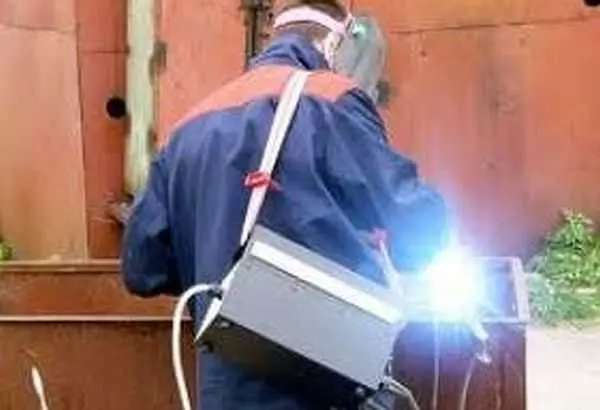
This small drawer is an inverter welding machine.
Most inverter welding machines operate from the household network 220 V (there are devices and from 380 V). And this is one of their advantages. Moreover, they practically do not affect it, i.e. Do not "sit" tension. As for the neighbors, be calm: they will not know that you are engaged in welding. The second important plus is that they can more or less normally work under reduced voltage. You must, of course, look in the characteristics, but at 170 to most of them, it still allows the electrode with a 3 mm electrode. This is very important especially for countryside, where low voltage is rather normal than an exception.
What is even good for newbies - that an arc with inverter welding and get and kept easier. And in general, according to many, it cooks from "softer" and his arc is "easier". So you want to learn to cook - try first inverter welding first.
On the choice of welding inverters for home and dacha read here.
Basics of welding inverter
To begin with, we will understand the design of the welding inverter. "Stuffing" will not consider it, we will examine that there is from above and what will have to use.
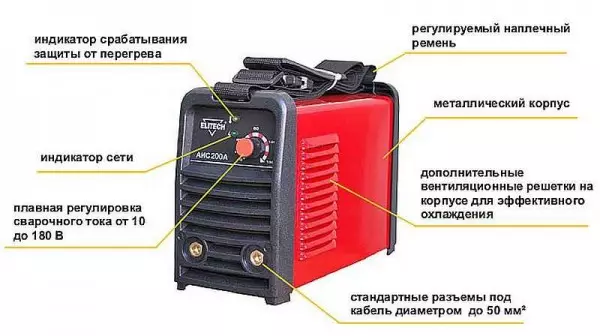
What is the inverter welding machine (to increase the size of the picture, click on it right key mouse)
This apparatus is a small metal box, which, depending on the power weighs from 3 kg to 6-7 kg. The housing is usually metallic, some manufacturers make ventilation holes in it - for better cooling "filling" (mostly transformer). For carrying there is a belt, sometimes there is also a handle: the belt is put on the shoulder if the work requires movement.
On one of the panels there is a key or a power toggle switch. In the face of the power and overheating indicators. Also there are knobs of voltage and welding current. Also on the front panel there are two outputs - "+" and "-" to which operating cables are connected. One cable ends with a cliff clamp that clings to the part, the second - the electrode holder. The power cable connector is as a rule, behind. That's actually all.
Article on the topic: Treatment of drywall before sticking wallpaper: What is included in it
When buying an inverter, pay attention to the cables are long and flexible: it is more convenient to work. It is on non-sufficiently long and rigid workers cables most of all complaints from users of the popular brand of welding inverter devices "Resanta".
General principles of working with invertor welding machine are told in this video.
Welding inverter for beginners
As with any electrical welding, the metal melting occurs due to the heat of the electric arc. It occurs between the welding electrode and the welded metal. To create an arc, they are connected to the opposite poles: one is served "+", on the second "-".
When connecting the electrode to "minus" and the details to the "plus" compound are called "direct". If the "plus" is served on the electrode - the connection is the opposite. And the other option is used during welding, but only for metals of different thicknesses: back - for welding of thin metals; Direct - for welding thick metals (more than 3 mm thick). But this is not an indisputable rule, sometimes come around.
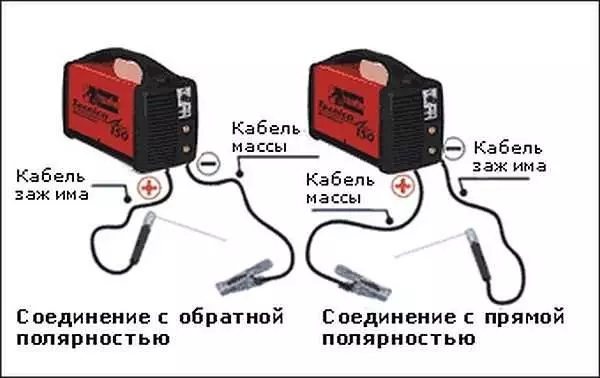
Direct and reverse polarity of connection on a welding inverter
What is the division caused in practice? Process physics. The electrodes in the event of an arc move from a minus to the plus. And there is also a positively charged surface at the same time, increasing its temperature. Therefore, the element that is connected to the positive exit, heats up more. When welding metals of sufficient thickness, they need to warm up well so that they fuse and the seam was high-quality. Therefore, they serve "+". Thin metal, on the contrary, the overheating can fire and they cling to it "minus", stronger than the heated electrode from which there is more molten metal in the seam.
It is possible to correctly cook the metal inverter only if the electrode is well controlled. To do this, you need to take the holder correctly. How to do it, look in the video.
How the seam is formed during welding
In order to welding the inverter to be clearer, consider what is happening in the formation of a seam. To begin with, we specify that the welding electrode for welding metals consists of a metal core and coating - a special coating that closes the welding area from the contact with oxygen contained in the air. Read more about the electrodes for inverters, read here.
Now actually about the process of welding. The electrical arc is formed when the core of the electrode and metal (how to ignore the arc read just below). At the same time, the coating begins to burn. It is partially melted, turning into a liquid state, partially turns into gases. These gases surround the welding zone - a welded bath. They do not "break through" oxygen from the air from the molten metal. The part of the coolant, which moved into a liquid state, covers the molten metal, creating a second layer of protection. After cooling, it turns into a slag that covers the seam with a crust. And at this stage, the slag protects the hot metal from oxygen.
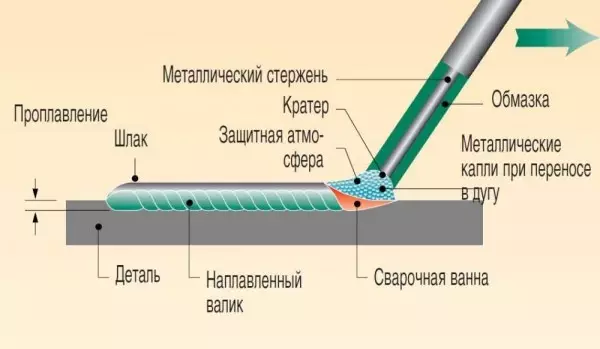
How is the welding inverter
But slag and protection is far from the only process that occurs, and which must be controlled. When welding, it is necessary to ensure that the place of the connection of two pieces of metal warmer is uniformly and enough. Both items should be melt at the same distance from the edge. In order for the heating to be uniform, you need to hold the same distance from the tip of the electrode to the part. It is not very simple to do: the electrode is melted during welding, and the particles of its molten metal are transferred to the arc. Therefore, there is a holder of the electrode gradually to make a closer to the part. But this does not yet end the technique of welding with an electrode. It is still necessary to write out his tip of "write" some shapes - zigzags, circles, Christmas trees, etc. They allow you to make seams wider and rush two details together. The most common movements of the electrode are presented in the photo below.
Article on the topic: Laggers for the floor: the size of the bar and such a distance between the lags, the table and the floor how to strengthen, the device in the house
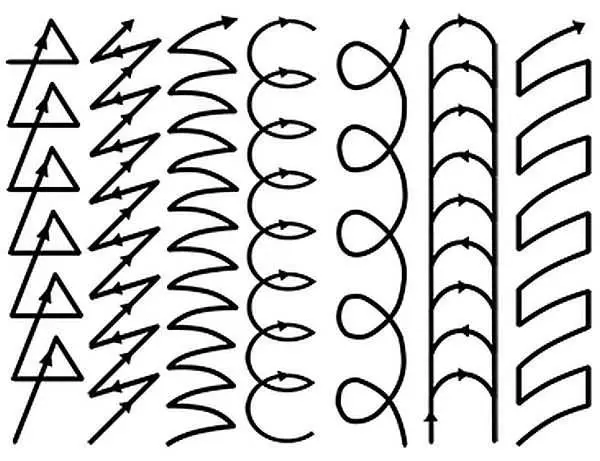
Electrode movements during welding inverter: For beginners, welders need to work several movements to automatism.
That is, moving the electrode is needed from side to the side to the width of the seam on one of these trajectories, while watching the welded bath is, and even lower the electrode as the electrode is extended, supporting the distance to the part constant. This is such a difficult task standing before who wants to learn to cook metal. The welding inverter is simpler - the arc is constant and does not jump, but at first you may not work.
In this video with a very large slowdown, the process of transferring metal particles from the electrode into a welded bath and how it is formed.
How to learn to weld metal inverter
Start learning from ignition arc. To do this, you will need apart from the apparatus, metal (5-6 mm thick) and the electrode still mask and kragi (dense leather gloves) of the welder, as well as tight clothing and shoes from thick skin - to protect against sparks and scale.
Start working from connecting welding cables. The chosen electrode is then inserted into the holder (for starters, take MP 3 with a diameter of 3 mm - they are easily ignited and boiled). After the power includes, the welding current is set (see the table). For electrode 3 mm, a current of 90-120 A. Current in the process of welding can be adjusted. If you see that it turns out not a roller, but just some incoherent stripes, increase it. If, on the contrary, the metal is very liquid and move the welded bath is difficult, reduce. The settings are very dependent on the machine and the selected electrode. So try, change. Turning the current to wear a welder's mask (newcomers will be easier to work in the chameleon mask), you can work.

General recommendations for choosing the diameter of the electrode depending on the thickness of the metal
Welding inverter for beginners begins with learning arc ignition. There are two methods: several times to knock the tip of the electrode in the detail or clarify them as a match. Both methods work. How it will be more convenient for you to use. But for the future, note that the chirk is needed along the seam line - so that the traces of the product remained. In order to resist the arc sustainably, you will have to practice for a while and burn several electrodes.
When the arc is lit up without any problems, you can move on - to master the movements. Do it making rollers on a thick metal. On the metal plate draw a chalk line that will replace your seam. Then ignite the arc. In the place where it rested, metal melts and covered with a film of liquid slag. This place is called a welding bath. Here it will have to move you along the drawn line. Do it one of the movements shown in the figure above.
Article on the topic: joints and gaps between the bathroom and the wall - what to do?
To the bath moves, the electrode needs to be slightly tilted, approximately at an angle of 50-45 °. Someone has a bigger corner, someone is less. In general, tilting the electrode, you change the size (width) of the welded bath. You can experiment: there are a lot of different techniques in welding and it is only important for the seam to be high-quality, and how you achieve it - your business, especially since you will work for yourself for yourself.
There are two main operating positions of the electrode: an angle forward and an angle back. When welding an angle forward, we get a smaller heating, the seam will get wider. This technique is used when welding thin metals . Tolstick weld, as a rule, an angle back.
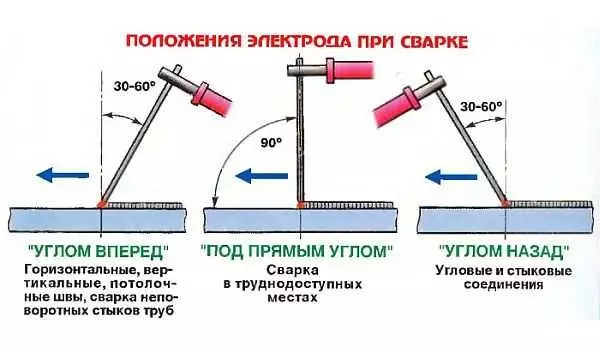
Positions of the electrode during welding and their use
But the angle of inclination is not all parameters that will have to withstand. There is still length of the arc. This is the distance from the tip of the electrode to the surface of the part. The average arc is 2-3 mm, short - 1 mm or in general, the length is long - 5 mm and more - before the separation. Practice begins with work on the middle length of the arc. Hold up to metal 2-3 mm. Then the seam will turn out to be smaller and better: with too much the gap of the arc begins to jump, heating metal is insufficient, the seam is wondering, the connection is unreliable. With a short arc, another problem occurs - the seam is too convex due to the fact that the warming zone is too small. This is also not good, since cutting remains - grooves along the seam on the part - the reduced connection strength.
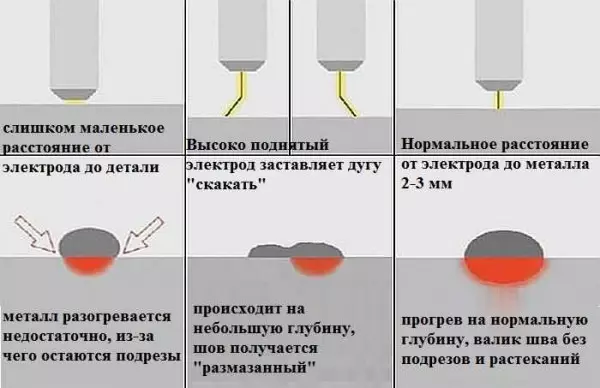
The length of the welding arc and its effect on the quality of the seam
Stretching for a while on the laying of rollers with different movements, you follow how rollers are the same width, the flakes of the surfacing have approximately the same dimensions, you can try to cook the seams. You can read about the types of seams and connections, as well as their preparation here, and you can see another lesson "Welding for teapots".
Basics of welding inverter for beginners all. Only practice remains: you need to lime not one electrode for training. Even maybe not one kilogram. When the hand itself will make all movements, everything will seem completely simple.
To secure the knowledge gained, see also this video clip. It is proposed to start a little straight hand without an electrode, working out the movement holding a pencil in hand. Also a good option, maybe he will seem more acceptable. In this video class on the welding inverter for beginners is very sensible, everything is simple and accessible. If there are some ambiguities, look at. You will understand how to properly cook inverter welding. For novice welders a lot of useful.
And finally, some features of the operation of welding inverters. They are very afraid of dust, especially metallic. Therefore, it is desirable next to them not to use the grinder and carry out regular cleaning with a vacuum cleaner inside (after the warranty period is completed). It is not recommended to work on the rain or in wet premises. This is especially true of low-cost household models. Although they have protection against electric shock, but it is better to be restrained.
By choosing the electrodes, pay attention to the area of use: they must be suitable for direct current. When welding at the large current or voltage, the operation mode is intermittent. It is specified for each apparatus in the passport.
